|
By: Jean-Claude Sabrier.
Pierre Le Roy's
'PETITE
RONDE'
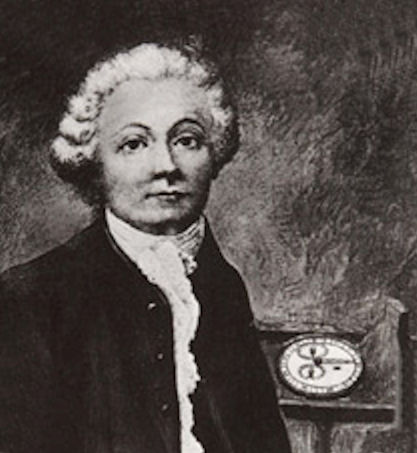
Pierre Le Roy (Paris1717–Vitry1785)
And his 'Mémoire
sur la meilleure manière de mesurer le temps en mer',
1770.
Table of contents:
Use 'F11' to
view full screen.
 SOME ASSUMPTIONS.
SOME ASSUMPTIONS.
Some assumptions
influencing the construction of his pocket watches
“for the use of astronomers and
seamen” were expounded by Pierre Le Roy for the first time in an article
appended in his:
Mémoire sur la meilleure manière de mesurer le
temps en mer,
(published in 1770).
|
Transcription:
“...they will never be as perfect
because of their small size which does not allow us that
employ all the devices for reduction of friction etc… that
we incorporate in our chronometers.
I believe however, that they may be made more accurate:
1)
by giving a more perfect isochronism to the balance
2)
by employing compensation for
the effects of heat and cold,
similar to that used by Mr Harrison in his timekeeper.
3)
by using a dead beat escapement
where the friction is a lot less than in a cylinder, etc.
By this I do not mean a
detent escapement, for the practical application of which, a
watch is, I believe, too small...."
|
 SULLY'S
ESCAPEMENT ENHANCED SULLY'S
ESCAPEMENT ENHANCED

Fig. 1
Sully's escapement.
|
Transcription:
“...The escapement of Mr. Sully where the wheel is
perpendicular to the plates, having been perfected, seems to
me the best way of achieving this reduction in friction.
With this last point in mind I have made several
watches, giving the escape wheel a size such that it go as
nearly to the dial on one side and nearly to the balance
spring on the other. I have also a given the teeth the form
of spokes to make the wheel very light, and in conjunction
with certain other improvements I believe it may now be
shown that because of the reduction of friction obtained by
the locking of the wheel very close to the balance staff,
this is the best escapement of all...”
|
 THE
FIRST PROPER EXAMPLE. THE
FIRST PROPER EXAMPLE.
The first proper example of this
type was made to the order of Monseigneur le Duc de Penthièvre , Grand Admiral
de France. It was apparently the only one to be submitted to the judged by the
Académie Royale des Sciences.
It is
also in this paper that he gives precise details of his motives for constructing
the first watch of this type and are reprinted and, more importantly, put in
order in Mémoire sur une nouvelle montre à l’usage des
astronomes et des marins,
read to the Academy on the 3rd
July 1771.
|
Transcription:
“....I
call them Seamen's watches and not Marine chronometers,
because they take the place of an ordinary pocket watch.
When employing them for use at sea, they are placed in their
suspension, somewhat similar to those I employ for my marine
chronometers, in order that they are maintained in the same
position and that position being the most propitious, will
enable them to go with even greater accuracy. In effect,
when the watch is flat, the balance is carried by the pivot
ends where the friction is a lot less than along the sides
and in addition, I have arranged the escapement in such a
way, that in this position, the action of the escape wheel
relieves the weight of the balance. This arrangement
together with the isochronism of the vibrations of the
regulator, achieved by the method published in my memoir,
the considerable reduction in friction This arrangement, together with the
isochronism of the vibrations of the regulator, achieved by
the method published in my memoir, the considerable
reduction in friction. However, the new feature, which is
very significant, is the compensation for the effects of
heat and cold. I mentioned in my appendix Mr Harrison's
which would be easy to apply to this English artist's
timekeeper but certainly not to a pocket watch; especially
when one considers that in regulating the length of the
balance spring, a strength is required which is not
consistent with the thin and narrow blades of metal that the
space in a watch would appear to allow. Besides, these
blades may only be very short so how is it possible for them
to exert sufficient effect on the balance spring.
I found the solution:
1) by making the blades work, not
directly on the spring itself, as in the timekeeper, but
through a lever which makes the effect five times more
sensitive.
2) by arranging the wheels in
such a way that there is sufficient space left to fit the
thermometer, by which I mean the blades. Their length is
almost equal to the diameter of the watch and their height
is almost that of the frame of the movement and they thus
have a strength that they would otherwise not have.
Consequently the thermometer
has another very important advantage and one found wanting
in that of Mr Harrison, which is to provide a simple means
of increasing or decreasing the desired effect, by means of
a screw which adjusts the proximity of the metal blades to
the centre of the lever.....
”
|
In order to place the
compensation blades between the two plates, Pierre Le Roy had to make the wheel
train without fusee.
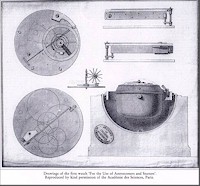
Fig. 3. (click to enlarge)
This first watch, which unfortunately has not been found, is
relatively well known through the drawings that accompany his memoir.
 TRIALS AT
SEA
TRIALS AT
SEA
On
board of the frigate
La Flore, during
the trials with marine timekeepers “A” and “S”, the watch was known as
the
Petite Ronde
because of the shape of the box that contains it.
 FOUR OTHER WATCHES OF
THIS TYPE ARE KNOWN
FOUR OTHER WATCHES OF
THIS TYPE ARE KNOWN
To
day, four other watches of this type are known to exist. Apparently
the second one to have been made is now in the Beyer Museum of Time
Measurement,
in Zurich.
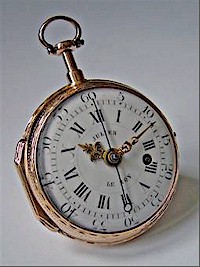
Fig. 5 (click to enlarge)
Almost certainly the second 'Petite
ronde'
made by Pierre Le Roy
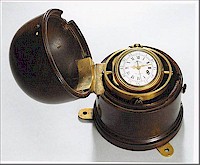
Fig. 7 (click to enlarge)
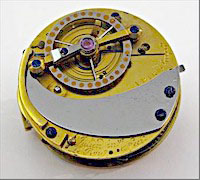
Fig. 9 (click to enlarge)
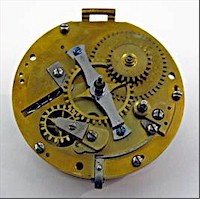
Fig. 11 (click to enlarge)
end
On this watch, which is
apparently the second one of the type, to have been made, the
compensation blades are set on the back plate in order to leave
enough room between the plates for a fusee.
In this arrangement however, the bimetallic
compensation is not adjustable.
 End of this
section, click here to continue.
End of this
section, click here to continue.
|
 Back to previous section.
Go to section end
Back to previous section.
Go to section end
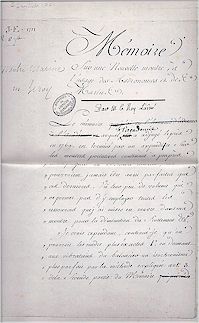
fig. 2 (click to enlarge)
Mémoire sur une Nouvelle montre
à l'usage des Astronomes et des Marins.
(go to
transcription)
 NO. 4732
NO. 4732
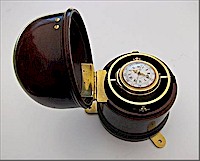
Fig. 13 (click to enlarge)
Le Roy No. 4732
appears to be he third watch of this type known to have been made. It is almost
identical to that in the Beyer Museum, but the temperature compensation device,
on the back plate is adjustable.
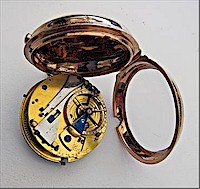
Fig. 15 (click to enlarge)
Le Roy 4536, Petite Ronde with adjustable
compensation blades on the back plate.
Private
collection.
 NO. 4757
NO. 4757
The two last watches of this type
known to exist are in the collection of the Patek Philippe Museum in Geneva.
One of
them is certainly the first ever made in France with a detached lever
escapement. Il carries the serial number 4757 and its temperature compensation,
has been constructed in England by George Daniels; in a time the two other
Petites Rondes were not
discovered yet, there for it was made after that, fitted on the back plate of
the watch by Ferdinand Berthoud, No 417, which then was the sole to be known
with a temperature compensation.
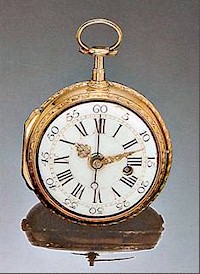
Fig. 17.
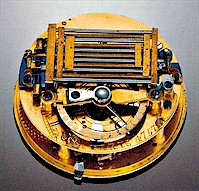
Fig. 19 (click to enlarge)
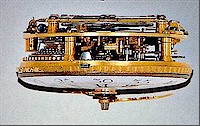
Fig. 21.
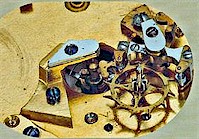
Fig. 23.
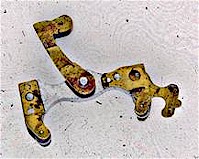
Fig. 23 (click to enlarge)
Pierre Le Roy 4757, the lever escapement
with roller pallets - Patek Philippe Museum
Its lever with roller pallets was
extremely heavy and therefore it never worked, due to its inertia.
 LE ROY
INVENIT, LARESCHE RENOVAVIT
LE ROY
INVENIT, LARESCHE RENOVAVIT
Also made as an
experimental piece, the other one, was specially conceived to be
used in a vertical position. Therefore, its balance was set into the
cage, perpendicularly to the plates. It is a double face watch and
its movement was found without dials, nor case. It was judged of
sufficient importance to be restored by Henri Lasreche in 1804, with
a very fine silver case with gold rims, and two white enamel dials
with hours and minutes on the front face, the seconds on the
reverse, the
central hand, revolving anti clockwise.
The front face carries the
inscription: Julien Le
Roy Invenit, Paris 1772, H. Laresche
Renovavit Paris 1804,
on the reverse.
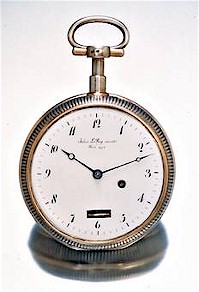
Fig. 27.
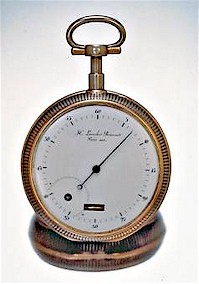
Fig. 29.
The
Montre de marins, as it was
named by Pierre Le Roy in his
Mémoir, as opposed to his
two celebrated
Montres Marines.
Patek Philippe Museum - Genève
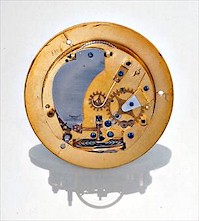
Fig. 31.
The movement fitted in a
ring, in order to
enlarge its diameter.
The fact it was the first marine
timekeeper ever made to be carried in a pocket, is certainly the main
interest of this watch.
.jpg)
Julien Le Roy
The dial is inscribed:
Julien
Le Roy Invenit 1772,
in order to commemorate the date of its invention by Pierre Leroy, who
almost
allways signed his pieces with the name of his father after his death in
order to glorify his memory.

:Jean-Claude
Sabrier.
2010 |
|
Editor: W.A. van Klaveren.
Producer: F. Kats.
Webmaster's note:
This article is subject to ongoing revisions.
 End of
article.
End of
article.
|


















.jpg)
